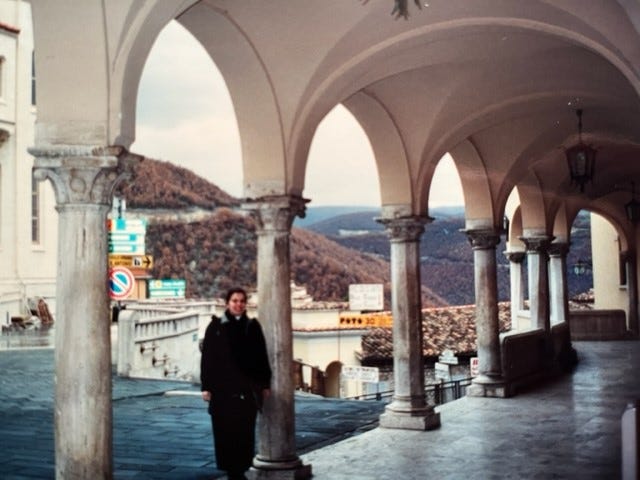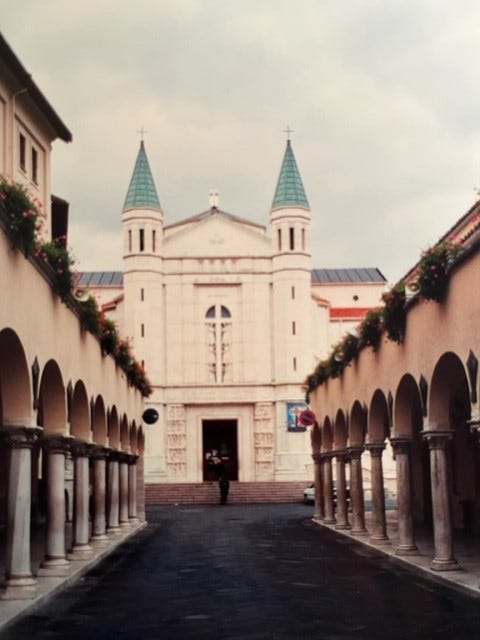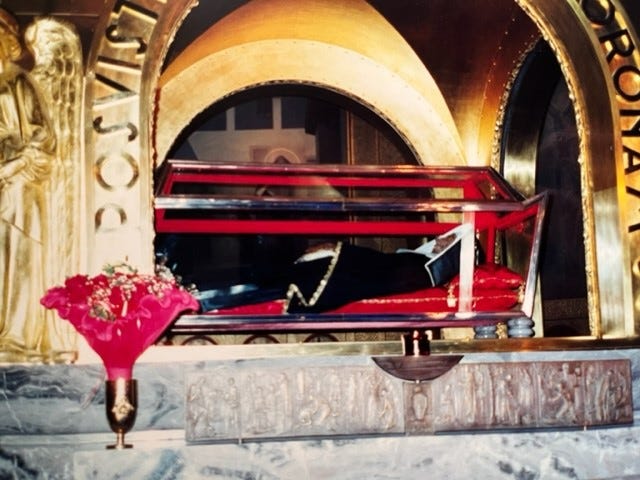November 25, 2000
Spello, Italy
The Apennines divide Umbria like uneven vertebrae up the spine of Italy. Yesterday, we crossed the ridge in search of a saint.
Near the central crest, in the province of Perugia, sits the comune of Cascia. We’re spending a couple nights in Spello. But today, we ascended the mountains on a spiritual quest.
In the car, two seats were occupied, but three of us made the trip. My wife is six months pregnant, and our feisty son was highly agitated by the winding roads.
Thru a gentle mist and fickle fog, I drove slow. We completed what’s normally an hour-drive in just under two, pulling over at Borgo Cerreto and Serravalle to soothe our son’s nerves and my wife’s stomach. But we pressed ahead. There was someone in Cascia we needed to see.
When she was confirmed as a Catholic, my wife looked thru the litany of saints to find a worthy patron to inspire, guide, and console her. It didn’t take long.
She did what many of us do. We check whose feast falls on our birthday. When she did, the saint she found shared not only a date, but a name, with the woman I married.
Margherita Lotti was born in 1381, in the hamlet of Roccaporena, about five miles from Cascia. From her earliest awareness, she was devoted to Christ and dedicated to His Church.
Rita wanted to join the Augustinian convent in Cascia. Her parents wanted her to wed. They arranged a marriage, which produced twin sons. They arrived when Rita was only twelve years old.
Her husband was allegedly a violent man who was unfaithful and abusive. But his wife prayed for…and with…him.
It worked. He eventually tamed his temper, yet couldn’t erase his pugnacious past. When he renounced a long-running feud with a nearby family, he was killed by his “allies” for turning his cheek.
Rita publicly pardoned the men who made her a widow. But her halo shed little light on her vindictive sons. They wanted vengeance, and were determined to get it.
Their mother was mortified that her children might murder. She asked God save her sons from sacrificing their souls to a mortal sin. He did. Within a year, both her boys avoided iniquity by dying of dysentery.
Having lost her family, Rita turned to the Church, and the dream she desired as a small girl. But the monastery she wanted to enter remained wary of the feud her family fought. It would only accept her if she could mend fences between the rival clans.
After much prayer and prodding (and pestilence), she did. Being on the verge of persuading her husband’s family to drop their grudge, the bubonic plague infected the brother who’d demanded revenge. Under his affliction, he relented to Rita, and abandoned the battle.
With the feud finally finished, Rita’s new life began. She was thirty-six when she entered St Magdalene Monastery. Over the years, she was diligent in her duties, yet wanted more.
She was always passionate about the Passion. Decades later, sixty year-old Rita prayed to Our Lord that she could share his suffering.
She often made this petition while kneeling before an image of Christ crucified. One day as she did, her forehead was pierced…wounded by a thorn from the crown that’d been pressed down on Our Lord.
Till her death, Rita gladly bore this mark and pain of pierced flesh. She was confined to bed the last few years of her life. Tuberculosis had weakened her to the point that daily Eucharist became her only sustenance.
In the dead of winter, Rita lay dying. A visitor asked her if there was anything she needed. She requested a single rose from what had been her parents’ garden.
It was a simple request…but at an impossible time. Bushes were buried under January snow. But hoping to humor a dying woman who was obviously delirious, the visitor returned to the garden.
To her astonishment, she found a single blossom on a solitary branch. She returned it to Rita, who gave thanks to God. The “saint of the thorn” would have her rose.
Rita died four months later, 512 years to the day before my wife was born. She was canonized May 24, 1900, by Pope Leo XIII. Her body has remained incorrupt, and is on display at the Cascia basilica that bears her name.
By the time we arrived, the temperature had dropped, but skies had cleared. Not that it mattered. Our destination was indoors.
The monastery and basilica are atop a steep hill in the center of town. The view of the charming village and surrounding Apennines is enchanting, and lovely.
The old part of the monastery, where St Rita spent the last four decades of her life, dates to the 13th century. It was enlarged in the 18th by a donation from King John V of Portugal, who was cured of cancer by intercession of the saint.
We entered the basilica thru a loggia receiving line. On either side, a procession of columns escorted us to the shrine.
The basilica was built in the early twentieth century to house the body and relics of St Rita. Pius XII raised it to the rank of minor basilica in 1955. The façade features white travertine from Tivoli. The interior layout is in the pattern of a Greek cross, its walls coated in colorful frescoes.
The portal is impressive, sculpted on either side with detailed scenes in the life of St Rita. Her body was never buried, and now rests in a separate chapel inside the church.
When we lived in San Francisco, our parish church of SS Peter and Paul contained a small chapel to the nun from Cascia. We took it as another sign that my wife had chosen her perfect saint. On many occasions, Rita would step inside to pray with the Umbrian nun who shared her name.
Neither of us ever imagined doing so in person. But today we did. Her incorrupt body lay before us, unchanged for five centuries since her soul ascended to the side of God.
In a clear coffin under a gold baldachin, she rested before us in the serenity of salvation. And beside her tomb, like an eternal flame, someone left the lasting gift of a single rose.
Like the woman with me on our pilgrimage today, St Rita never begrudged hard work, nor shied from suffering. Even in death, she was destined to endure it.
Because she salvaged a rose and rehabilitated her husband, Rita would be known as the patron saint of lost causes…and of marriage. I guess God knew that anyone capable of bearing those burdens must also possess a sense of humor.
JD







